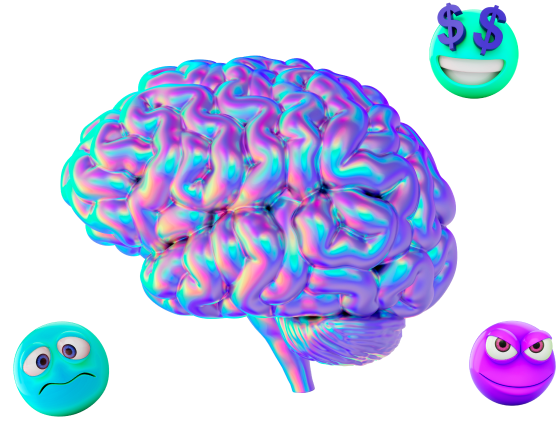- Mercados
- Trading
- Plataformas
- Herramientas y formación
Herramientas
- T4Trade
- Blog
- Login
- Registro
 ES
ES
La psicología del trading comprende todos los componentes mentales y emocionales que participan en el proceso de toma de decisiones mientras operamos en los mercados. Se refiere, por tanto, a aquellos aspectos de la personalidad y del comportamiento del trader que influyen en sus resultados.
Hay muchas maneras en las que se manifiestan estos rasgos del carácter, ya sea a través del miedo, la codicia, la arrogancia o incluso la esperanza. De estas cuatro emociones, se considera que son el miedo y la codicia las que tienen una influencia directa en la psicología del trading, particularmente en lo que respecta a los riesgos que cada uno quiere tomar y a la disciplina que decide adoptar.
Si nos dejamos llevar por la codicia podemos llegar a tomar decisiones que quizá son demasiado arriesgadas. Si nos dejamos llevar por el miedo podemos perder oportunidades u operar con excesiva precaución, sin conseguir ganancias significativas. El desarrollo de la autoconciencia puede ayudar al trader a identificar sus patrones negativos de comportamiento recurrente y de qué forma nublan su juicio.
De esta manera, podrá modificar su comportamiento para ser más objetivo y racional a la hora de tomar decisiones.

Cuando estudiamos la psicología del trading tratamos de dilucidar las causas de las decisiones poco sensatas que toman los traders en los mercados o en otros asuntos financieros. En concreto, las finanzas conductuales integran la psicología y las finanzas con el objetivo de investigar el impacto que tiene el comportamiento humano en las elecciones financieras y los resultados del trading.
En otras palabras, identifica las influencias psicológicas y los sesgos que subyacen al comportamiento de traders y profesionales financieros y explora cómo este comportamiento puede afectar a los resultados del mercado. Las finanzas conductuales también se utilizan para entender mejor los resultados obtenidos en distintos sectores e industrias.
Uno de los principios de esta disciplina es que los participantes de los distintos mercados no son perfectamente racionales ni tienen un control total sobre sí mismos, sino que están influidos por factores psicológicos y tendencias que son relativamente comunes y que se pueden controlar.
Las finanzas conductuales también proponen que la toma de decisiones en el contexto financiero viene condicionada por el bienestar mental y físico de la persona o, dicho de otro modo, que el estado mental del inversor depende de su estado de salud general. Algunos de los sesgos más comunes de la conducta son el exceso de confianza, el efecto manada, la contabilidad mental, la brecha emocional, el anclaje, el error de atribución y la aversión a las pérdidas.


Otro término habitual en el ámbito de la psicología del trading es lo que se conoce como trading (o inversión) emocional. El trading emocional es similar a las finanzas conductuales, y engloba aquellas conductas que vienen motivadas por la volatilidad de los mercados y que desembocan en la compra o la venta de activos.
El trading puede verse influido por una gran variedad de emociones, como el pánico, la avaricia, el entusiasmo, el miedo e incluso el exceso de confianza.
Algunos ejemplos habituales de decisiones emocionales de trading son el trading en exceso (overtrading), la venta en pánico o el sesgo de confirmación, entre otros. Mantener a raya las emociones exige una buena dosis de inteligencia emocional, de cara a no perder la disciplina y gestionar el estrés psicológico de la forma adecuada. Mediante la inversión en el desarrollo personal y el compromiso con el aprendizaje continuo el trader podrá adquirir habilidades fundamentales como autocontrol, empatía y confianza, que le ayudarán a mantener a raya las emociones en sus operaciones.
Engaging in ongoing learning and investing in personal development will help a trader acquire vital skills like self-regulation, empathy, and confidence.

Otro aspecto fundamental de la psicología del trading es lo que se conoce como instintos de trading, que son aquellos sentimientos intuitivos o instintivos que los traders pueden experimentar al tomar decisiones en los mercados.
Para poder tener confianza en nuestros propios instintos debemos desarrollar la autoconciencia y la habilidad para discernir las decisiones racionales y legítimas de las que tomamos siguiendo nuestros impulsos. Se trata, por tanto, de darnos cuenta de que nuestra objetividad puede verse alterada o nublada por distintos sesgos y de tomar las medidas para rectificar ese problema en consecuencia.
Hay tres fenómenos que suelen influir en la toma de decisiones racionales: el sesgo sensorial (formarse una opinión con información potencialmente sesgada), la aversión a la vaguedad (el miedo a lo desconocido) y la tangibilidad de la anticipación (cuando el sentimiento de anticipación se convierte en el foco en sí mismo, en lugar de aquello que lo provocó).

Gracias por visitar T4Trade
Este sitio web no está dirigido a residentes en la Unión Europea, y queda fuera de los marcos regulatorios europeos y de la normativa MiFID II.
Haga clic a continuación si desea visitar T4Trade de todos modos
Gracias por visitar T4Trade
Este sitio web no está dirigido a residentes en el Reino Unido, y queda fuera de los marcos regulatorios europeos y de la normativa MiFID II, así como de las reglas, directrices y protecciones establecidas en el manual de la Financial Conduct Authority del Reino Unido.
Haga clic a continuación si desea visitar T4Trade de todos modos